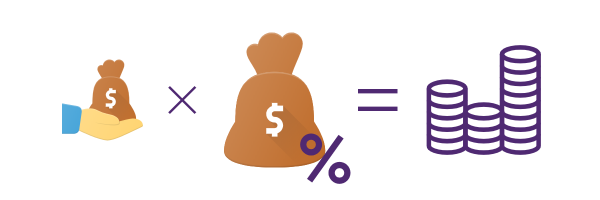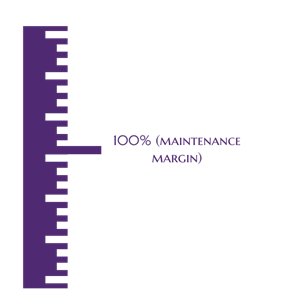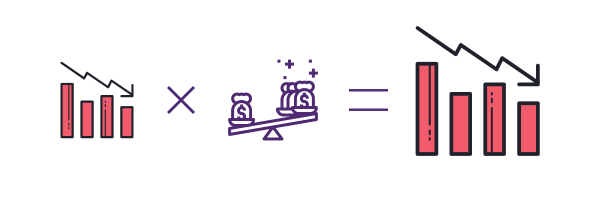Margin solves the problem of large financial requirements
One of the main requirements in Forex trading, as well as in other markets, is to have a significant position size that can lead to larger payouts. It goes like this: if you buy a currency pair with more funds, you’ll be able to collect increased payouts and turn them into a significant reward.

Even though many traders cannot afford to deposit large funds, the majority of Forex brokers offer a kind of a trading loan - a certain sum of funds that traders can use for trading. This is called leverage and leveraged funds make initial deposits much larger than they were before. But leverage also comes with a margin account cash deposit requirement.
What is margin in Forex and how does it work?
Service providers don’t usually provide leveraged funds in a blind trust to their clients. Imagine this: a trader uses the leverage of 1:200 for his $1,000 deposit. When applied, the leverage will turn that initial deposit into a $200,000 trading position, where $199,000 belongs to the broker. It’s hard to imagine someone who would give such a large amount of money away without some assurances.
That is where margin comes in. It is a tool that allows service providers to give out large sums of funds to their clients while, at the same time, take a certain piece of that fund from a trader.
The margin is represented in a percentage rate and the way it works is like this: Let’s say you have the account balance of 5,000 Japanese yen and you want to open a trade of USD/JPY with a position size
one lot (100,000 yen). Without margin and leveraged funds, you would need to refill your account and deposit an additional 95,000 yen yourself.
With margin, however, a service provider allows you to open that same trade without the need to deposit such a large sum. As we said, the margin is represented in percentages and for our example, let’s say the margin requirement is 2%. The margin requirements in Forex usually vary from 1-2% for such position sizes. So, in this case, if you want to open a trade worth 100,000 yen, the Forex broker would take 2,000 yen from your account balance as a payment for the loan.

Therefore, your account balance of 5,000 yen would be totally enough to buy a USD/JPY pair for one lot. And what is more, 3,000 yen from your balance would still be available for other trades.
Benefits of margin trading
Margin account makes the account size considerably larger, we already know that. The result of this is that the possible payouts increase as well. Let’s get back to our example and see how this works:
As we said, you opened a position to buy USD/JPY currency pair for one lot with just 2,000 yen of your own money. Now, if you used just that 2,000 yen, you would be able to buy about 18 dollars at the exchange rate of 109.69 (2,000/109.69). Now, if the price increased to 109.72 and you sold the pair, you would get 2,000.55 yen back. The result is just 0.55 yen of payout.
But when the margin account is used, the payouts increase significantly. If you did the same trade but instead of 2,000 yen, you used a 100,000 position, you would be able to get 27.5 yen in payout (0.55x50=27.5). Of course, even a 27.5 yen payout is not significant on a larger scale, but when combined with other trades, then it can become sufficient enough.
Difference between margin and leverage
When talking about margin, we might often mention leverage and leveraged funds. These two terms are interconnected and pretty similar in many ways, but there is a difference between them too.
As we already mentioned, the margin is a deposit on your account balance that is needed to open new and increased trading positions. It is a requirement from your broker. Leverage, on the other hand, is the ability to increase your positions and have access to a lot more assets.
When it comes to calculating the leverage ratio, a margin requirement can be useful. For example, if a broker has a 2% margin requirement, the ratio would be 2/100, i.e. 1/200. Usually, the leverage is represented like this: 1:200. Therefore, the connection between the leverage ratio margin requirement is quite deep.
The most important terms
Now, there are several major terms related to a margin that we need to explain:
- Available equity
- Used margin
- Margin level
- Maintenance margin
- Margin call
Available equity
In the previous example, we saw how you can increase your trading position using leverage. At the beginning of that example, we mentioned that you have 5,000 yen on your account. This is the real deposit that you made from your pocket and it is called available equity.
Available equity indicates how much funds a trader has to open additional trades. When using a margin account, service providers take necessary funds (2,000 yen in our case) to open a leveraged trade from available equity.
Used margin and locked up funds
Then comes the used margin. This is the amount of money taken from the Forex broker to open a leveraged position. It’s some sort of a service cost that the service provider needs.
In our example, 2,000 yen that the broker took, is a used margin. And every time you try to open new trades, the used margin will become larger because a service provider will need more insurance funds from you.
Forex margin level
With the above-mentioned tools - available equity and used margin - traders can calculate another important tool: margin level. What is margin level in Forex? It is a balance between the two tools discussed above and can be calculated by dividing available equity by used margin, reflected in a percentage.
For example, when you have a 5,000 yen available equity and 2,000 yen used margin, the margin level will be (5,000/2,000)x100%=250%. Therefore, you have a 250% margin level on your account right now. The higher the margin level, the more funds you have to open additional trades.
Maintenance margin
Now, keeping check of the margin level is very important when using a margin account. That’s because it enables a trader to see whether or not their account balance is sufficient to open new trades.

If a trader is happy with the number of trades they made and want to have them open, they need to have the minimum amount of funds stored on the balance. In trading, this is called the maintenance margin and usually, many Forex brokers require a 100% for the minimum maintenance margin level. This means that your existing funds are equal to those taken by your broker and no additional positions can be opened.
What is margin call in Forex?
When your Forex trade finishes successfully, meaning the price on USD/JPY pair goes up and then you sell it, your account balance also increases. But there are chances that the price will go down and lead you to a loss. This way, your account balance will decrease as well.
That is where the margin level goes below 100%. This means that the available equity on your balance is lower than the funds taken by your broker. So, how to increase margin level in Forex? If this happens, the broker will notify you that you need to refill your account at least to the point of maintenance margin. This is basically a definition of
margin call.
If you manage to do that, your current positions will stay open. However, if you fail to make a new deposit, the broker will have to close all trades and sell your assets. Forex traders are usually very careful not to get a margin call and maintain their account above the maintenance margin.
Margin also has disadvantages
We have talked about the benefits and great uses of margin trading in Forex. Margin allows traders to go for higher trading positions, buy more currency pairs, and possibly get larger payouts.
However, the margin comes with its own disadvantages as well. On the one hand, increased position size makes payouts bigger but it also makes losses bigger. Let’s return to our example. When you opened a trade for USD/JPY with a 100,000 yen leveraged position, you were able to get a 27.5 yen payout from the increase in price.

But the price could go down as well, which would make losses even larger. If the price went down from 109.69 to 109.66, you would get 1,999.45 yen back, instead of 2,000. The loss would be 0.55 yen. But if you used margin, you would, again, lose 27.5 yen (0.55x50=27.5) because the position size would be higher.
Therefore, it can be a good idea to use margin accounts and leveraged funds more carefully.